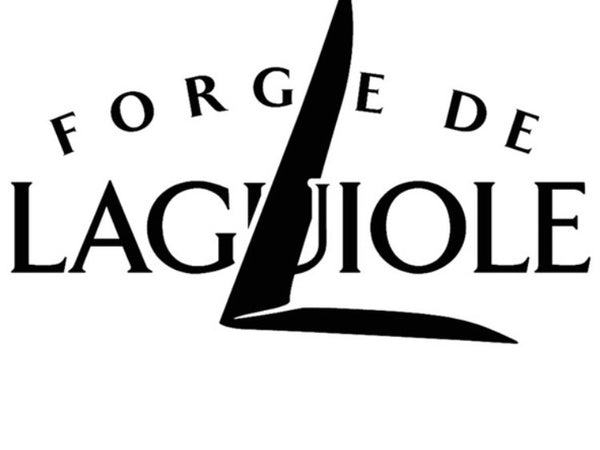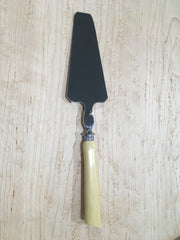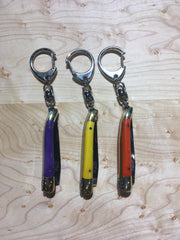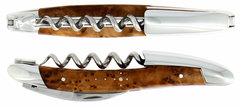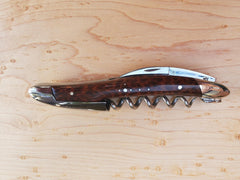Forge De Laguiole
The early blacksmiths of Laguiole called the original knife the "capuchadou", a multitool knife used by peasants of the Aubrac plateau. The blade of the knife was pointed and the handle made from oak or boxwood.
1829: the first Laguiole folding knives
Casimir-Antoine Moulin is the first cutler-blacksmith to set up shop in Laguiole.
Monsieur Glaize sets up his cutlery and forge in rue du Valat, in Laguiole.
The first folding knife produced in Laguiole in the 1820's was the Laguiole Droit, the straight Laguiole, a knife without a decorated bee and with a forced notch. The handle was made from bone or ivory, and finished in the shape of a bird's beak. The blade had a "bourbonnaise" shape with a centred point. The model was made in Laguiole until 1900.
1840: an awl was added to the basic Laguiole
As time goes by, Pierre-Jean Calmels perfects his technique and soon introduces the folding knife, adding in 1840 an awl in response to the needs of shepherds and livestock farmers.
Between 1850 and 1860 the current shape of the Laguiole appears and becomes gradually refined. The blade curves up slightly in the Yatagan style and the handle has an elegant shape.
Since the 1820's
All the knife-makers of Laguiole forged the blades and the springs of their knives by hand. The steel came from the Pyrenees and the Tarn region.
"In the past, the forge was located in the back shop. The blades were sharpened on a small grindstone pulled by a dog. The blades were tempered in the volcanic cold waters of «La Violette» (a local spring) to harden them. The knives were assembled in the light of day at the front of the workshop. Each workshop employed at that time between 5 and 7 workers in extremely cramped premises. The knives made in Laguiole during that period were full handle models made from Aubrac cow horn or bone, plentiful materials in the area, or from ivory for more precious knives."
Christian Lemasson, The History of the Laguiole Knife
1880: the Laguiole becomes a sommelier
In 1880, the Laguiole knife has a third piece added: the corkscrew. This was due to the sale of wine in bottles in urban society, but also in response to the request by the people of Aveyron who had left to find work in the cafés of Paris. Café owners and waiters were to remain loyal to their traditions, and were proud to use their 3-piece knife for customers in the capital.
1900: the Laguiole is gentrified
The springs are decorated for the first time. The bee is sculpted with a flower motif, and the back of the spring is decorated with alternating triangular patterns. The Laguiole knives are shaped and decorated entirely by hand, using a file.
In 1900, Laguiole knife-manufacturing is at its highest level and 30 people are employed in the forges of Laguiole.
The same year, at the Universal Exhibition in Paris the knifemakers Pagès and Calmels are awarded a Médaille d’Or (gold medal). In the space of 10 years, the Laguiole knifemakers were to be honored with around 20 medals in recognition of the quality of their knives.
In 1909 the first bee appears instead of the floral motif. The ivory handles are carved and sculpted in various forms, including horse's hooves, rattlesnake tails, butterflies, ram's heads and clovers. New knives appeared during the Edwardian and Art Nouveau periods, their handles made from ivory and carved in the shape of the heads of people such as Napoleon, Joan of Arc and Venus. Certain models had a pattern of engraved flowers which required extremely fine carving.
The First World War (1914-1918) leads to the disappearance of the cutleries in Laguiole. From the end of the war, a proportion of the Laguiole knives are produced in Thiers.
From the 1960's Laguiole's customers - largely agricultural workers are in decline, the production of handmade knives is minimal and, by the beginning of the 1980's, knife-manufacture in Laguiole has almost ceased to exist.
1987: the return of Laguiole knives to Aubrac
In 1985, a group of Laguiole enthusiasts from the Aubrac plateau create the conditions for the return of Laguiole knife manufacture to its birthplace. The renaissance of the Forge de Laguiole becomes a reality in 1987.
